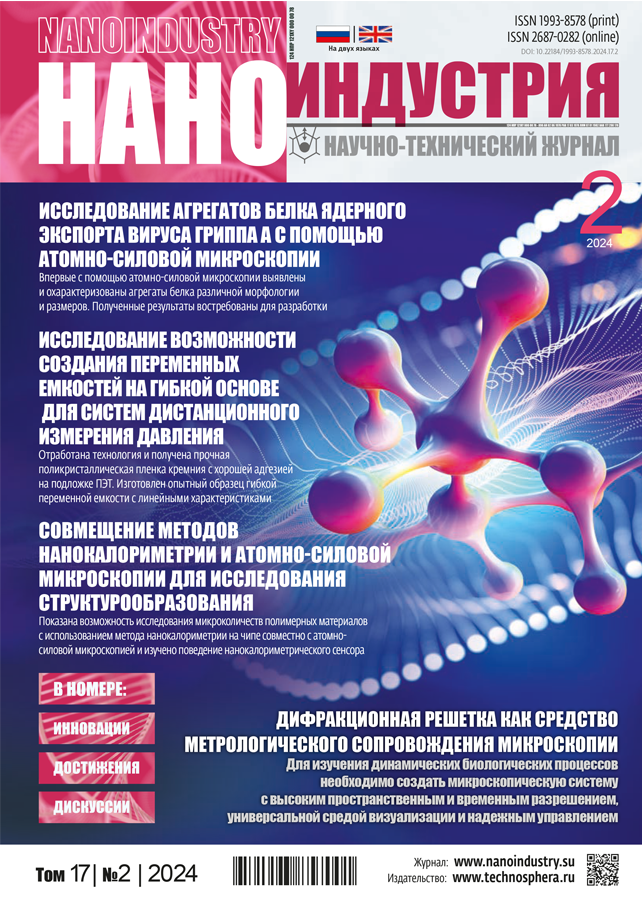Исследование процесса формирования наночастиц оксида меди, стабилизированных глицерил кокоатом
- Авторы: Голик А.Б.1, Нагдалян А.А.1, Блинов А.В.1, Закаева Р.Ш.2, Леонтьев П.С.1, Тараванов М.А.1, Рехман З.А.1, Аскерова А.С.1
-
Учреждения:
- Северо-Кавказский федеральный университет
- Северо-Осетинская государственная медицинская академия
- Выпуск: Том 17, № 2 (2024)
- Страницы: 144-154
- Раздел: Наноматериалы
- URL: https://journals.eco-vector.com/1993-8578/article/view/640881
- DOI: https://doi.org/10.22184/1993-8578.2024.17.2.144.154
- ID: 640881
Цитировать
Полный текст
Аннотация
В данной работе образцы наноразмерного оксида меди, стабилизированного глицерил кокоатом, получали методом химического осаждения в водной среде. Исследования микроструктуры методом сканирующей электронной микроскопии показали, что образец оксида меди представлен агломератами неправильной формы размером от 1 до 30 мкм, которые состоят из наночастиц диаметром от 5 до 50 нм. Исследования фазового состава показали, что полученный образец представляет собой оксид меди (II) с кристаллической моноклинной-бета-решеткой, в данном случае пространственная группа соответствует C2/с. В результате компьютерного квантово-химического моделирования взаимодействия глицерил кокоата и оксида меди установили, что представленное соединение является энергетически выгодным (∆E = 1714,492 ккал/моль) и взаимодействие происходит через карбоксилат-анион. Данное соединение обладает значением химической жесткости η ≥ 0,050 эВ, что свидетельствует о его стабильности. Методом ИК-спектроскопии было установлено, что взаимодействие глицерил кокоата и оксида меди происходит через карбоксильную группу. В ходе оптимизации методики синтеза было установлено, что для получения НЧ CuO со средним гидродинамическим радиусом менее 200 нм оптимальными параметрами являются температура от 95 до 100 °С, масса ацетата меди от 3 до 4 г и концентрация стабилизатора ПЭГ-7 от 1–3%.
Ключевые слова
Полный текст
Об авторах
А. Б. Голик
Северо-Кавказский федеральный университет
Email: zafrehman1027@gmail.com
ORCID iD: 0000-0003-2580-9474
ассистент
Россия, СтавропольА. А. Нагдалян
Северо-Кавказский федеральный университет
Email: zafrehman1027@gmail.com
ORCID iD: 0000-0002-6782-2821
к.т.н., доц.
Россия, СтавропольА. В. Блинов
Северо-Кавказский федеральный университет
Email: zafrehman1027@gmail.com
ORCID iD: 0000-0002-4701-8633
к.т.н., доц.
Россия, СтавропольР. Ш. Закаева
Северо-Осетинская государственная медицинская академия
Email: zafrehman1027@gmail.com
ORCID iD: 0000-0002-9930-6055
к.х.н., доц.
Россия, ВладикавказП. С. Леонтьев
Северо-Кавказский федеральный университет
Email: zafrehman1027@gmail.com
ORCID iD: 0000-0001-6532-5816
лаборант
Россия, СтавропольМ. А. Тараванов
Северо-Кавказский федеральный университет
Email: zafrehman1027@gmail.com
ORCID iD: 0000-0003-3243-3241
лаборант
Россия, СтавропольЗ. А. Рехман
Северо-Кавказский федеральный университет
Автор, ответственный за переписку.
Email: zafrehman1027@gmail.com
ORCID iD: 0000-0003-2809-4945
ассистент
Россия, СтавропольА. С. Аскерова
Северо-Кавказский федеральный университет
Email: zafrehman1027@gmail.com
ORCID iD: 0009-0002-9852-3055
лаборант
Россия, СтавропольСписок литературы
- Махмутов Б.Б., Ким Ю.А. Биосенсоры глюкозы, основанные на реакции ее окисления наночастицами Сu, оксидов меди, их сплавов/композитов: краткий обзор // Международный журнал прикладных и фундаментальных исследований. 2021. № 4. С. 17–24.
- Данилаев М.П. и др. Капсулирование дисперсных частиц оксида меди (I) полилактидом // Конденсированные среды и межфазные границы. 2023. Т. 25. № 1. С. 27–36.
- Горлушко Д.А. и др. Синтез оксида меди для катализаторов конверсии монооксида углерода, 2019.
- Choi B.N. et al. Effect of morphological change of copper-oxide fillers on the performance of solid polymer electrolytes for lithium-metal polymer batteries // RSC advances. 2019. Vol. 9. No. 38. PP. 21760–21770.
- Zhou X. et al. Nano-catalytic layer engraved carbon felt via copper oxide etching for vanadium redox flow batteries // Carbon. 2019. Vol. 153. PP. 674–681.
- Подлеснов Е., Чиркунова Н.В., Дорогов М.В. Методика получения нановискеров оксида меди для литий-ионных аккумуляторов // ББК 1 А28. 2020. С. 112.
- Жуков Е.Е., Ильясов С.Г. Влияние способа сольватотермической модификации поверхности компонентов пиротехнических составов наноразмерным оксидом меди (II) на изменение скорости горения // Южно-Сибирский научный вестник. № 5. С. 102–107.
- Каракич Е.А., Самборук А.Р., Майдан Д.А. Термитная сварка // Современные материалы, техника и технологии. 2021. № 1 (34). С. 63–67.
- Badawy A.A. et al. Efficacy assessment of biosynthesized copper oxide nanoparticles (CuO-NPs) on stored grain insects and their impacts on morphological and physiological traits of wheat (Triticum aestivum L.) plant // Biology. 2021. Vol. 10. No. 3. P. 233.
- Naz S., Gul A., Zia M. Toxicity of copper oxide nanoparticles: a review study // IET nanobiotechnology. 2020. Vol. 14. No. 1. PP. 1–13.
- Waris A. et al. A comprehensive review of green synthesis of copper oxide nanoparticles and their diverse biomedical applications // Inorganic Chemistry Communications. 2021. Vol. 123. P. 108369.
- Chakraborty N. et al. Green synthesis of copper/copper oxide nanoparticles and their applications: a review // Green Chemistry Letters and Reviews. 2022. Vol. 15. No. 1. PP. 187–215.
- Лейер Д.В. Использование нанотехнологий в строительстве // VII Международный студенческий строительный форум. 2022. P. 282.
- Блинов А.В. и др. Синтез и исследование влияния параметров дисперсионной среды на агрегативную устойчивость наночастиц оксида меди // Вестник Московского государственного технического университета им. Н.Э.Баумана. Серия "Естественные науки". 2022. № 4 (103). С. 95–109.
- Блинов А.В. и др. Синтез и исследование структуры наноразмерного оксида меди (II), стабилизированного полиэтиленгликолем // Вестник Московского государственного технического университета им. Н.Э.Баумана. Серия "Естественные науки". 2020. № 3 (90). С. 56–70.
- Cortés H. et al. Non-ionic surfactants for stabilization of polymeric nanoparticles for biomedical uses // Materials. 2021. Vol. 14. No. 12. P. 3197.
- Cheng K.C. et al. Design and performance optimisation of detergent product containing binary mixture of anionic-nonionic surfactants // Heliyon. 2020. Vol. 6. No. 5.
- Mahmoud D.B. et al. Scrutinizing the feasibility of nonionic surfactants to form isotropic bicelles of curcumin: a potential antiviral candidate against COVID-19 // AAPS PharmSciTech. 2022. Vol. 23. PP. 1–12.
- Мингазова А.Р., Большакова А.Ю. Исследования поверхностно-активных свойств эмульгаторов для создания эмульсионных растворителей АСПО // European Scientific Conference. 2019. PP. 88–90.
- Wuchner K. et al. Industry perspective on the use and characterization of polysorbates for biopharmaceutical products Part 1: Survey report on current state and common practices for handling and control of polysorbates // Journal of pharmaceutical sciences. 2022. Vol. 111. No. 5. PP. 1280–1291.
- Дрейпер Н., Смит Т. Прикладной регрессионный анализ / 3-е изд. М.: Вильямс, 2016.
- Блинов А.В., Пирогов М.А., Гвозденко А.А. [и др.] Компьютерное квантово-химическое моделирование взаимодействия наночастиц селена с четвертичными аммониевыми соединениями // Физико-химические аспекты изучения кластеров, наноструктур и наноматериалов. 2023. № 15. С. 357–366. https://doi.org/10.26456/pcascnn/2023.15.357
- Gilbert A. Introduction to IQmol. Электронный источник: https://www.q-chem.com/Teaching%20Materials/IQmol-Intro-II_new.pdf
- Лунев В.А. Математическое моделирование и планирование эксперимента: Учебное пособие. СПб: Изд-во Политехн. ун-та, 2012.
Дополнительные файлы










